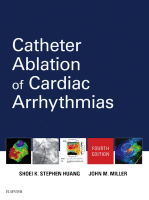Physical Address
304 North Cardinal St.
Dorchester Center, MA 02124

Key Points Mechanism The mechanism of postinfarction monomorphic ventricular tachycardia (VT) is generally reentrant myocardial excitation through surviving myocyte bundles within the infarct scar. Diagnosis and Mapping The diagnosis is made by excluding supraventricular and preexcited causes of broad complex…

Key Points The mechanism of idiopathic mitral and tricuspid annular ventricular tachycardias (VTs) is nonreentry (triggered activity or automaticity). Mitral annular VT has a right bundle branch block (RBBB) pattern and monophasic R or Rs in leads V 2 to…

Key Points Ventricular outflow tract tachycardias include the right or left ventricular (LV) outflow tracts, aortic cusps, pulmonary artery, and the corresponding epicardium (LV summit region). The mechanism underlying outflow tract arrhythmias is usually triggered activity, and the site of…

Key Points The approach to the difficult accessory pathway ablation is, first, to exclude cognitive ablation failure by confirming the tachycardia diagnosis and reevaluating the electrograms. Second, use a systematic approach to identify contributing technical factors, such as pathway-related factors…

Key Points Atriofascicular accessory pathways are decrementally conducting accessory pathways that are most commonly located along the right free wall, connecting the atrium to the right bundle branch. They participate in antidromic tachycardia with a left bundle branch block morphology,…

Key Points Diagnosis of superoparaseptal ( anteroseptal ) and midseptal accessory pathways (APs) is made on the basis of an electrocardiographic pattern (if overt preexcitation is present) and evidence of midseptal/anteroseptal AP insertions during intracardiac mapping studies. Orthodromic supraventricular tachycardia…

Key Points Posteroseptal accessory pathways (APs) are not true septal pathways but are located in the complex inferior pyramidal space involving the right atrium, right ventricle, left ventricle, left atrium, and coronary sinus and its branches. Mapping often needs to…

Key Points The atrioventricular (AV) annulus is mapped for atrial or ventricular accessory pathway (AP) insertion sites or the AP itself. Ablation targets include the earliest site of atrial or ventricular activation by the AP, sites of AP potentials, and…

Key Points Mapping uses a combined anatomy- and electrogram-guided approach. The right-sided approach target is just proximal to or below the His bundle electrode position on the fluoroscopic view, or at the proximal His location. The left-sided approach target is…

Key Points Mechanism of atrioventricular nodal reentrant tachycardia (AVNRT) is reentry involving fast and slow atrioventricular (AV) nodal pathways. The typical slow–fast form of AVNRT is diagnosed by the presence of a long atrium–His bundle (AH) interval (>180 ms) during…